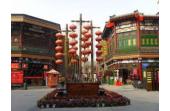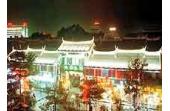Tianjin Ancient Cultural Street is located in the Nankai District
of the Tianjin Municipality and was formally opened in 1986. It is
located on the west bank of the Haihe River, with Tianhou Palace as
its geographical center. Tianjin Ancient Cultural Street begins at
Gongbei Avenue in the north, and ends at Gongnan Avenue in the
south, being 0.36 miles long and 16 feet wide. Although essentially
a business street, Tianjin Ancient Cultural Street attracts
tourists who come to see its special architectural styles, admire
its classic cultural features, buy various folk crafts, and sample
the delicious local Tianjin snacks. Above all, as visitors walk
along the street, they will be particularly impressed by the
splendid replica classical architecture in the folk style of the
Qing Dynasty (1644-1911).Standing at the center of Tianjin Ancient Cultural Street, Tianhou
Palace, originally built in 1326, is one of only three Mazu Temples
in the world (the other two are Fujian Mazu Temple and Beigang
Chaotian Temple on Taiwan Island). Tianhou Palace is now the
Folk-custom Museum of Tianjin and displays many folk crafts and
cultural relics of ancient times. Yuhuang Cabinet (Yuhuang Ge) is
the only building that was built during the Ming Dynasty
(1368-1644) in Tianjin, and is the oldest structure in the street.
From the top of the two-floor Cabinet, visitors have a bird's-eye
view of the whole street. Another building, Tong Qingli (ancient
residential houses), built in 1913 and lying to the east of the
cultural street, is the largest architectural edifice that combines
both eastern and western architectural elements.











